
As the Society of Broadcast Engineers grew and evolved in serving its members, it also expanded its role in being a technical voice in broadcasting issues. After the Communication Act of 1934 was passed to consolidate the regulation of telephone, telegraph and radio communications under the oversight of the Federal Communications Commission (which replaced the Federal Radio Commission), subsequent changes added television broadcasting in 1967 and cable TV in 1984.
One of the first efforts by the SBE to express its voice on a larger scale, the SBE formed the SBE Technical Advisory Committee in October 1978. The committee”s goal was to represent the SBE on panels, board and industry committees on matters relating to SBE and broadcast interests.
This committee”s first chance to participate came in 1979 when the Society of Motion Picture and Television Engineers asked the SBE to be part of a committee to write technical standards for the digital control and interface of automatic television control systems.
Later, the SBE began submitting comments to the FCC rulemaking process and even making visits to legislators and the FCC in Washington, DC. SBE Past President Richard Rudman, CPBE, on business trips to DC, would often schedule appointments.
In the 1980s, the SBE began making regular FCC filings via an ad hoc committee headed by Dane Ericksen, CSRTE CBNT 8-VSB, which later became a formal under the FC Liaison Committee about 1991, which Ericksen chaired. In 2008, the FCC Liaison Committee was reorganized and given an updated mission as the Government Relations Committee by then SBE President Barry Thomas, CPBE DRB CBNE, which was launched in 2008.
Over the years, the SBE has gained a respected voice in the industry. The SBE has been asked to partner on filings by other organizations, including the NAB, MSTV, the ATSC, and even governmental agencies.

SBE efforts to affect legislation have included visits to Capitol Hill, like the one pictured above in 2011. Left to right: Vinny Lopez, CEV CBNT (then past president); Barry Thomas, CPBE DRB CBNE (past president and then Government Liaison Committee chairman); Ralph Hogan, CPBE DRB CBNE (then president); Chris Imlay (general counsel); John Poray, CAE (executive director)
Certification Expansion
The SBE”s Program of Certification was launched in 1975, but in December 1978, an FCC action brought on an update to the program: The FCC eliminated the Third-Class operator license. This left a void in broadcasting for an entry-level standard to demonstrate a person”s technical abilities. The SBE began developing a new level of certification.
In October 1980, the SBE unveiled its plan to create the Certified Broadcast Technologist (now abbreviated as CBT) level of certification. The CBT is now the first level of what I have always called the �core four� levels of SBE certification. The other three are the Certified Broadcast Engineer (CBRE and CBTE), the Certified Senior Broadcast Engineer (CSRE and CSTE) and Certified Professional Broadcast Engineer (CPBE).
In 1995, the FCC eliminated all licensed operator requirements at radio stations, and in response, the SBE created the Certified Radio Operator (CRO) and Certified Television Operator (CTO) levels of certification. The SBE is currently revising the �SBE Certification Handbook for Radio Operators,� which is the preparation guide to take the CRO exam. The second edition of the book is in its final stages of editing and will be available by the end of 2014.
�
�
Scherer is a contract engineer and recording engineer in Kansas City, and former editor of Radio magazine.






